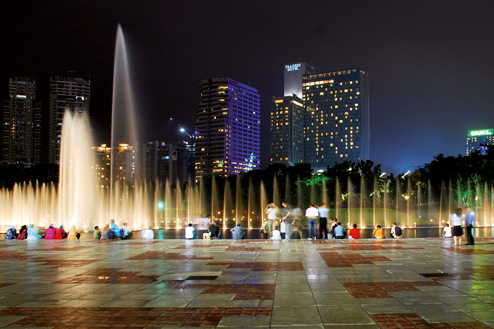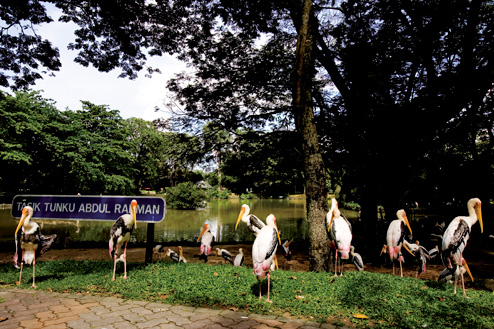Brickfields
Although the area around Masjid Jamek just to the north of Chinatown is called ‘Little India’, Brickfields might also have a legitimate claim to the name. The largest number of the inhabitants of this fascinating part of Kuala Lumpur are Indian-Malaysians, and how this came to be is a fascinating story. In the 1870s, Kuala Lumpur was expanding fast and the demand for building materials was high. An enterprising businessman, Yap Kwan Seng, saw the potential of the rural area now known as Brickfields. One of its main features was a huge clay quarry which would provide excellent material for the fabrication of high quality bricks. Yet the area also retained its agricultural character for a long time after it became a centre for the production of bricks; hence the blending of the two words, ‘brick’ and ‘fields’.
Meanwhile, the British were developing the KTM – Malaysia’s railway system. Having already put an excellent rail system in place in India, they knew that it was the place to go for trains and an efficient, cost-effective work force. Many of the new workers settled in Brickfields, where their descendants remain until this day. The colourful Jalan Rosario still has scores of the original railway quarters built at this time.
Modern Brickfields is roughly between Bangsar and Chinatown and retains much of its historic character. Old shophouses operate next to modern skyscrapers. It’s a hustling, bustling, vibrant community famed for its many restaurants and hawker stalls where delicious local food is sought out by local connoisseurs. This is the place to go for a banana leaf lunch, or to sample thosai or roti pisang, both a sort of banana pancake. Another local favourite is curry laksa, a spicy soup.
In spite of its Indian flavour, Brickfields offers a variety of culinary experiences. Jalan Tun Sambanthan bustles with Malay, Chinese, Vegetarian and Indian Muslim restaurants as well as more standard Indian eateries offering some of the best and most affordable Indian fare in town.
After lunch go shopping for gold and silver jewellery, saris and rich silks. Be sure to drop by Sri Kota Shopping Center. Wherever you are, bargain hard.
Brickfields is also known as the ‘Divine Location’ because of the many famous temples and shrines in its streets, not all of them Hindu. Don’t miss the Buddhist Maha Vihara Temple, the Aminmegu Sree Veera Haouman Temple, the Lutheran Church, or the Three Teachings Chinese Temple on Jalan Thambipillay.
Brickfields also has a lively nightlife, which may explain why one of Kuala Lumpur’s four police district headquarters is located there. Once known for its relatively high crime rates, Brickfields’ reputation is now much better.
It is bordered roughly by Jalan Travers in Bangsar, Jalan Tun Sambanthan 4 and Jalan Sayed Putra. Kuala Lumpur Sentral Station is in Brickfields and provides the easiest access point to it. Located on the corner of Tun Sambanthan and Tun Sambanthan 4 is the large YMCA, which offers a number of community activities – even lessons in Scottish dancing.
Meanwhile, the British were developing the KTM – Malaysia’s railway system. Having already put an excellent rail system in place in India, they knew that it was the place to go for trains and an efficient, cost-effective work force. Many of the new workers settled in Brickfields, where their descendants remain until this day. The colourful Jalan Rosario still has scores of the original railway quarters built at this time.
Modern Brickfields is roughly between Bangsar and Chinatown and retains much of its historic character. Old shophouses operate next to modern skyscrapers. It’s a hustling, bustling, vibrant community famed for its many restaurants and hawker stalls where delicious local food is sought out by local connoisseurs. This is the place to go for a banana leaf lunch, or to sample thosai or roti pisang, both a sort of banana pancake. Another local favourite is curry laksa, a spicy soup.
In spite of its Indian flavour, Brickfields offers a variety of culinary experiences. Jalan Tun Sambanthan bustles with Malay, Chinese, Vegetarian and Indian Muslim restaurants as well as more standard Indian eateries offering some of the best and most affordable Indian fare in town.
After lunch go shopping for gold and silver jewellery, saris and rich silks. Be sure to drop by Sri Kota Shopping Center. Wherever you are, bargain hard.
Brickfields is also known as the ‘Divine Location’ because of the many famous temples and shrines in its streets, not all of them Hindu. Don’t miss the Buddhist Maha Vihara Temple, the Aminmegu Sree Veera Haouman Temple, the Lutheran Church, or the Three Teachings Chinese Temple on Jalan Thambipillay.
Brickfields also has a lively nightlife, which may explain why one of Kuala Lumpur’s four police district headquarters is located there. Once known for its relatively high crime rates, Brickfields’ reputation is now much better.
It is bordered roughly by Jalan Travers in Bangsar, Jalan Tun Sambanthan 4 and Jalan Sayed Putra. Kuala Lumpur Sentral Station is in Brickfields and provides the easiest access point to it. Located on the corner of Tun Sambanthan and Tun Sambanthan 4 is the large YMCA, which offers a number of community activities – even lessons in Scottish dancing.













